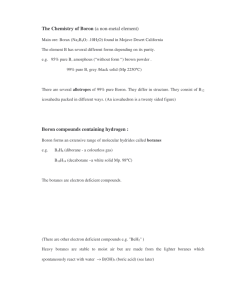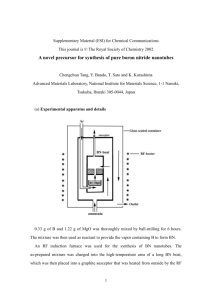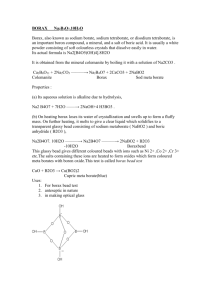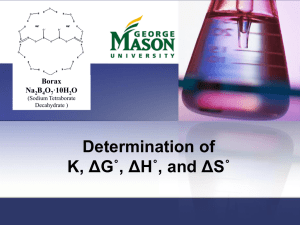9. GROUP 13 ELEMENTS (IIIA) ns np
advertisement
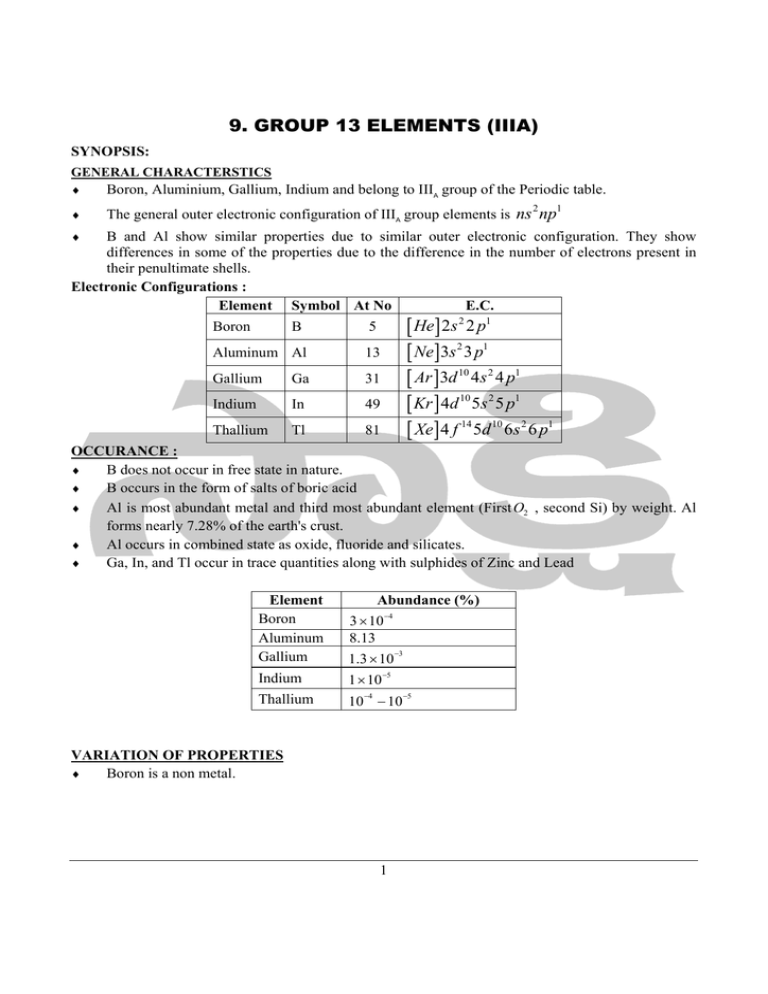
9. GROUP 13 ELEMENTS (IIIA)
SYNOPSIS:
GENERAL CHARACTERSTICS
♦
Boron, Aluminium, Gallium, Indium and belong to IIIA group of the Periodic table.
♦
The general outer electronic configuration of IIIA group elements is ns np
2
1
♦
B and Al show similar properties due to similar outer electronic configuration. They show
differences in some of the properties due to the difference in the number of electrons present in
their penultimate shells.
Electronic Configurations :
Element Symbol At No
E.C.
Boron
B
[ He] 2s 2 2 p1
[ Ne]3s 2 3 p1
[ Ar ]3d 10 4s 2 4 p1
[ Kr ] 4d 10 5s 2 5 p1
[ Xe] 4 f 14 5d 10 6s 2 6 p1
5
Aluminum Al
13
Gallium
Ga
31
Indium
In
49
Thallium
Tl
81
OCCURANCE :
♦
B does not occur in free state in nature.
♦
B occurs in the form of salts of boric acid
♦
Al is most abundant metal and third most abundant element (First O2 , second Si) by weight. Al
forms nearly 7.28% of the earth's crust.
♦
Al occurs in combined state as oxide, fluoride and silicates.
♦
Ga, In, and Tl occur in trace quantities along with sulphides of Zinc and Lead
Element
Boron
Aluminum
Gallium
Abundance (%)
1.3 × 10
Indium
1 × 10
Thallium
10 − 10
3 × 10
8.13
−4
−3
−5
−4
VARIATION OF PROPERTIES
♦
Boron is a non metal.
1
−5
Group 13 Elements (IIIA)
♦
♦
Al , Ga, In, and are metals.
Atomic radius increases suddenly from B to Al .
This is due to the greater screening effect of electrons present in the penultimate shell.
The atomic radii of Al and Ga are same.
This is because of the poor shielding effect of d-electrons in Gallium
Density increases from Boron to Thallium
The m.p.'s and b.p's of IIIA group elements do not show any regular trend.
This is due to the difference in their crystal structures.
Melting points order B > Al > Tl > In > Ga
Boiling points order B > Al > In > Ga > Tl
♦
Melting point of Gallium is very low because it contains Ga2 molecules.
♦
Boron has high m.p because it exists as a giant covalent polymer both in liquid and solid
Gallium exits as a liquid between 29.80C and 20000C. So Gallium is used in high temperature
thermometry.
The order of B > Tl > In > Ga > Al .
The most electropositive element in IIIA group is Al.
♦
♦
♦
♦
♦
♦
♦
♦
♦
♦
♦
♦
♦
♦
The compounds of Al and Ga (Ex: AlCl3 and GaCl3 ) are covalent only in the anhydrous state and
Ionic in aqueous solution because their hydration energies, compensate the ionaization energies.
Boran forms an oxide and a nitride when burnt in air. But Al does not undergo any change and
remains in tact because it forms an oxide layer
At high temperature Al gives its nitrides.
The common oxidation state of these elements is +3
Boron shows -3 and +3 oxidation states.
Ga, In and Tl exhibits +3 and +1 oxidation states
2
Group 13 Elements (IIIA)
♦
Due to inert pair effect +1 oxidation state of Tl is more stable than its +3 oxidation state.
ANOMALOUS PROPERTIES OF BORON
♦
Boron is non mental.
♦
It always forms covalent compounds
♦
Boron show diagonal relationship with Si.
♦
Boron does not displace hydrogen from acids
♦
Oxide of boron B2O3 is acidic oxide
♦
♦
♦
♦
♦
Hydroxide of boron is acidic ( B ( OH )3 or H3 BO3 )
Maximum covalency of boron is 4
Boron form stable covalent hydrides which are known as bornanes.
Boron never appears as a cation
Among halides of boron only BF3 undergoes complete hydrolysis.
Boron
Preparation :
♦
In the laboratory, it is prepared by reducing B2O3 with metallic magnesium.
♦
95-98% pure boron is obtained on reducing B2O3 with Mg or Na metal at high temperature. It is
known as "Moissan Boron". This is amorphous Boron.
Δ
B2O3 + 3Mg ⎯⎯⎯⎯⎯
→ 2 B + 3MgO
bright red hot
♦
B2O3 is obtained from borax
♦
Borax is treating with hot conc. HCl gives H 3 BO3 Boric acid ( H 3 BO3 ) on fusion loses water and
forms B2O3 .
♦
Na2 B4O7 + 2 HCl + 5H 2O ⎯⎯
→ 2 NaCl + 4 H 3 BO3
♦
red heat
4 H 3 BO3 ⎯⎯⎯
→ H 2 B4O7 ⎯⎯⎯→
− H 2O
(Orthoboric acid)
435 k
− H 2O
tetraboric acid
B2O3
♦
♦
H 3 BO3 ⎯⎯⎯
→ HBO2
375 k
− H 2O
Metaboric acid
⎯⎯⎯→
red heat
− H 2O
Pyrolysis of BI 3 (or) thermal decomposition of boranes also gives crystalline Boron.
PHYSICAL PROPERTIES :
♦
Boron exists in two allotropic form
a) Amorphous B b) Crystalline B.
♦
Amorphous B dissolves in molten Al at 15300C which on cooling gives yellow colored
crystalline solid. Al is eliminated by dissolving in HCl. This results in very hard crystalline B.
♦
B is a non conductor of electricity
♦
B sublimes at ordinary pressure
CHEMICAL PROPERTIES :
3
Group 13 Elements (IIIA)
♦
Action with air (or) O2 : Amorphous B, on heating in air to about 7000 C , form B2O3 and BN
4 B + 3O2 ⎯⎯
→ 2 B2O3
2 B + N 2 ⎯⎯
→ 2 BN
♦
With non metals : On heating amorphous B will react with N 2 , O2 , S , F2 , Cl2 and Br2 directly
forming binary compounds
4 B + 3O2 ⎯⎯
→ 2 B2O3
1200 C
2 B + 3S ⎯⎯⎯
→
0
B2 S3
Boron tri − sulphide
Hardest compound of Boran is Boran carbide ( B4C )
♦
Reducing property : B is a powerful reducing agent for CO2 and SiO2 .
3SiO2 + 4 B ⎯⎯
→ 2 B2O3 + 3Si
♦
With Conc. acids B gives boric acid
B + 3HNO3 ⎯⎯
→ H 3 BO3 + 3NO
2 B + 3H 2 SO4 ⎯⎯
→ 2 H 3 BO3 + 3SO2
♦
When fused with alkalies, B liberates
2 B + 6 NaOH ⎯⎯
→ 2 Na3 BO3 + 3H 2 ↑
USES :
♦
B is a good neutron absorber. B and BC3 are used in the shielding of atomic piles and in the
control rods used for controling of chain reactions.
♦
High purity B is used as a semi conductor in the place of Ge and Si
♦
Boron is essential minor element for the healthy growth of plants
BORAX : The most common meta borate is borax. Na2 B4O7 .10 H 2O or Na2 [ B4O5 (OH ) 4 ].8H 2O
Borax available in nature as tincal or kerinite or Razorite ( Na2 B4O7 .4 H 2O ) . From these two
minarals decahydrate is obtained by extracting.
Structure of Metaborate ion ( H 4 B4O92− ) :
PROPERTIES :
♦
Borax is sparingly soluble in cold water. Its aqueous solution is alkaline in nature due to
hydrolysis
Na2 B4O7 + 2 H 2O ⎯⎯
→ .2 NaOH + H 2 B4O7
♦
Borax exists in three crystalline form
a) Prismatic borax ( Na2 B4O7 .10 H 2O )
4
Group 13 Elements (IIIA)
b) Octahedral borax ( Na2 B4O7 .5 H 2O )
c) anhydrous sodium tetraborate ( Na2 B4O7 )
BORAX BEAD TEST :
♦
This test is useful in the identification of basic radicals in qualitative analysis. On heating borax,
swells into a white, opaque mass of anhydrons sodium tetra borate. When it is fused, borax glass
is obtained B2O3 . combined with metal oxides give coloured beads
fused
Na2 B4O7 .10 H 2O ⎯⎯
→ Na2 B4O7 ⎯⎯⎯
→ 2 NaBO2 + B2O3
B2O3 + CoO ⎯⎯
→ Co ( BO2 )2 (Cobalt metaborate).
(Blue bead)
S.NO
1
Basic Metal metaborate
Colour of the bead
radical
formed
Cu 2+
Cu ( BO 2 )2
Green
2
Fe2+
Fe ( BO 2 )2
Yellowish brown
3
Cr 3+
Cr ( BO 2 )2
Yellow
4
Mn 2+
Mn ( BO 2 )2
Violet
5
Ni +2
Ni ( BO 2 )2
Violet
USES OF BORAX
♦
Borax bead test is used in the identification of basic radicals. This test uses borax
♦
Borax is used as a flux in soldering, in welding and in certain metallurgies
♦
In making optical glasses Pyrex glass.
♦
In leather industry for cleaning hides and skin
♦
As preservative borax is useful
BORIC ACIDS : B2O3 in water gives boricacids
Ortho boric acid H 3 BO3 or B2O3 .3H 2O
Meta boric acid HBO2 or B2O3 .H 2O
Tetra boric acid H 4 B2O7 or 2 B2O3 .H 2O
Pyro boric acid H 6 B4O7 or 2 B2O3 .3H 2O
PREPARATION OF BORIC ACID :
♦
Ortho boric acid is prepared from Colemanite ( Ca2 B6O11 ) . Finally powdered colemanite is
suspended in hot water and SO2 gas is passed to saturate it. The reaction is
Ca2 B6O11 + 9 H 2O + 2SO2 → 2CaSO3 + 6 H 3 BO3
♦
When hot solution of borax is mixed with H 2 SO4 gives boric acid
N 2 B4O7 + H 2 SO4 + 5H 2O → Na2 SO4 + 4 H 3 BO3
5
Group 13 Elements (IIIA)
PROPERTIES
♦
It is a mono basic acid
♦
H 3 BO3 loses water on heating
at 100 C
H 3 BO3 ⎯⎯⎯
⎯
→ HBO2 + H 2O
0
160 C
4 H 3 BO3 ⎯⎯⎯
→ H 2 B4O7 + 5H 2O
0
hightemp
2 H 3 BO3 ⎯⎯⎯⎯
→ B2O3 + 3H 2O
BORON HYDRIDES :
♦
The ores of Boron are
♦
The hydrides of boron are called boranes.
♦
These are electron deficient molecules.
♦
(
)
They can be classified as boranes Bn H n +4 and hydroboranes ( Bn H n +6 )
( Bn H n+4 ) type ( Bn + H n+6 ) type
B2 H 6 Diborane
B4 H10 Tetra borane
B5 H 9 Penta borane -9
B5 H11 Penta borane -11.
B6 H10 Hexa borane -10
B6 H12 Hexa borane -12 .
B10 H14 Deca borane-14
B10 H16 Deca borane -16.
PREPARATION OF B2 H 6 :
♦
Industrial method : BF3 on reduction with LiH gives Diborane.
450 K
2 BF3 + 6 LiH ⎯⎯⎯
→ B2 H 6 + 6 LiF
♦
BCl3 on reduction with LiAlH 4 gives B2 H 6 ( Lab method)
dry ether
4 BCl3 + 3LiAlH 4 ⎯⎯⎯
⎯
→ 2 B2 H 6 +3LiCl + 3 AlCl3
♦
A mixture of BCl3 and H 2 at low pressure when subjected to silent electric discharge gives
B2 H 6 ( Lab method)
PROPERTIES OF B2 H 6 :
♦
♦
It is stable in the absence of grease and moisture.
It reacts with water forming boric acid and H 2
B2 H 6 + 6 H 2O → 2 H 3 BO3 + 6 H 2 ↑
♦
It reacts with alkalies with evolution of H 2 .
B2 H 6 + 2 KOH + 2 H 2O →
♦
2 KBO2
potassiummetaborate
+ 6H 2 ↑
It reacts with Cl2 to give BCl3 .
6
Group 13 Elements (IIIA)
B2 H 6 + 6Cl2 → 2 BCl3 + 6 HCl
B2 H 6 + Br2 → B2 H 5 Br + HBr
♦
It burns in O2 gas to give B2O3
B2 H 6 + 3O2 → B2O3 + 3H 2O
♦
In presence of , diborane reacts with HCl to give chloro diborane
B2 H 6 + 3O2 → B2O3 + 3H 2O
♦
It reacts with CO at 1000C and 20 atm pressure to give borane carbonyls.
B2 H 6 + 2CO → 2 BH 3CO
♦
It reacts with sodium amalgam to give B2 H 6 Na2
♦
It reacts with ammonia at 1200C to form diammoniate of diborane .
Which is on strong heating gives borazole and hydrogen
0
120 C
B2 H 6 + 2 NH 3 ⎯⎯⎯
→ B2 H 6 .2 NH 3
Δ
B2 H 6 .2 NH 3 ⎯⎯⎯
→
Δ
0
200 C
B3 N 3 H 6
borazole
or inorganic benzene
At high temperature
Δ / at 200 C
n B3 N 3 H 6 ⎯⎯⎯⎯
→ 3 ( BN )n + 3nH 2
0
STRUCTURE OF B2 H 6 :
3
♦
The hybridisation of Boron in Diborane is sp .
♦
In B2 H 6 two Boron atoms and four hydrogen atoms are in one plane.
♦
The four hydrogen atoms which lie in one plane are called terminal hydrogen atoms. The
remaining two hydrogen atoms are called bridge hydrogen atoms.
This is further confirmed by methylation of diborane to give Me 4 B2 H 2
♦
One of the bridge hydrogen atom is above the plane of the molecule and the other bridge
hydrogen atom is below the plane of the molecule
The terminal H atoms involve in covalent bonds. Bridge H atoms are involved in three centred
two electron bond.
This is called Banana bond or Hydrogen bridge bond or Tau bond.
The bridge hydrogen atoms involve three centre two electron bonds.
Diborane molecule has 4 covalent bonds, 2 de-localised bonds.
There is no direct bond between 2 Boron atoms.
H
o
H
H
1.33 A
♦
♦
♦
♦
♦
121.5 (B 97
(B
o
1.19 A
H
H
7
H
Group 13 Elements (IIIA)
ALUMINIUM :
♦
Bauxite is the important mineral
♦
Bauxite contains impurities such as Fe2 O3
(red Bauxite) and SiO2 (white Bauxite)
CHEMICAL PROPERTIES OF AL :
conc.HNO3
dil.HNO3
conc.H 2SO 4
dil.H 2SO 4
Al
dil / conc.HCl
dil.NaOH
Fused NaOH
No reaction
Al ( NO3 )3 + NH 4 NO3 + H 2O
Al2 ( SO4 )3 + H 2O + SO2
Al2 ( SO4 )3 + H 2
AlCl3 + H 2
−
2 ⎡⎣ Al ( OH )4 ( H 2O )2 ⎤⎦ + 3H 2 ↑
2 AlO3−3 + 3H 2 ↑
Aluminium metal is used in
♦
Making electrical cables.
♦
Making trays and picture frames
♦
In metallurgy as deoxidiser for removing blow holes.
♦
Making light and strong alloys. These alloys are used in making parts of air crafts.
♦
Painting Iron surface to prevent its rusting.
♦
Thermite welding.
♦
Al foils are used for wrapping cigarettes, chacolates etc.
ALLOYS OF ALUMINIUM :
S.NO
Alloy
Composition
Uses
Balance beams,
Magnalium 2-15% Mg
1
85-98% Al
Lab articles etc.
Aluminum
10-12% Al
Utensils, jewellery
2
Bronze
90-88% Cu
3
Duralumin
4
γ − alloy
95% Al
4% Cu
0.5% Mg
0.5% Mn
92.5% Al
2.0% Ni
4.0% Cu
1.5% Mg
8
In making air ships
In making
aeroplane Parts
Group 13 Elements (IIIA)
ALUMS:
♦
Alums are double sulphates .
♦
The general formula of an alum is
X 2 SO4 . Y2 ( SO4 )3 . 24 H 2 O
X is a mono valent ion like
Na + , K + , Rb + , Cs + , NH 4+
3+
3+
Y is a trivalent ion like Fe , Al , Cr
♦
3+
Potash Alum - K 2 SO4 . Al2 ( SO4 )3 . 24 H 2 O
ChromeAlum - K 2 SO4 . Cr2 ( SO4 )3 . 24 H 2 O
FerricAlum - ( NH 4 )2 SO4 . Fe2 ( SO4 )3 . 24 H 2 O
SodiumAlum - Na2 SO4 . Al2 ( SO4 )3 . 24 H 2 O
♦
The co-ordination number of any cation in the alum is 6. Every cation in any alum is co-ordinated
with six water molecules.
♦
Lithium cannot form the alums because the maximum covalency of Lithium ion is only 4.
♦
Aqueous solution of any alum is acidic due to the hydrolysis of cation.
PREPARATION OF POTASH ALUM
♦
By concentrating solution, containing equimolar quantities of potassium sulphate and Aluminium
sulphate, to the point of crystallization alum separates out.
♦ Alunite
♦
{K SO .Al (SO )
2
4
2
4 3
.4Al ( OH )3 } is boiled with dilute H 2 SO 4 and a calculated amount of
potassium sulphate and crystallized to get alum.
Alum shale or pyrites shale ( Al2 O3 .xSiO2 + FeS 2 ) is roasted in air and the mass is digested with
dil H 2SO 4 . Ferrous sulphate formed in the roasting process is removed by fractional
crystallization.
PROPERTIES ALUM :
♦
It is an ionic compound and so does not exist in the
molecular forms in solutions
♦
It is a crystalline substance, soluable in H 2 O . The aqueous solution is acidic in nature due to
hydrolysis
♦
It loses its water of crystallization on heating.
USES OF POTASH ALUM :
♦
Used in the purification of water
♦
As a mordant in dyeing industry.
♦
For tanning leather.
♦
As a styptic to arrest bleeding.
9

